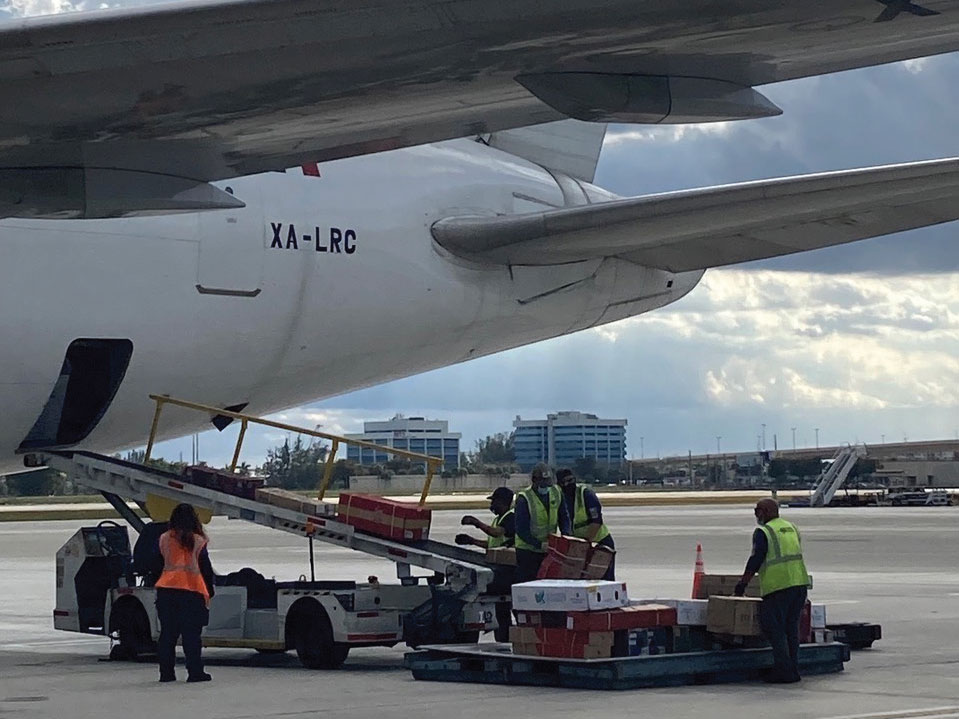Miami floral cargo pushes airport expansion
• Miami International Airport has plans to double air cargo warehousing space.
• Floral imports are blooming and warehouse space is running out.

Driven in large part by burgeoning volumes of fresh cut flower imports, the Miami International Airport has plans to expand air cargo warehousing space.
As a center for Western Hemisphere air commerce, Miami has long been a bastion for passenger and cargo business between Latin America and North America.
Now, according to Jimmy Nares, section chief aviation marketing, Miami Dade Aviation Department, the airport is preparing to greatly expand its cargo space. The aviation department of the Miami-Dade County government owns, operates, and manages Miami International Airport (MIA).
Nares explained in late April, “MIA is rapidly approaching its cargo capacity. To keep up with forecasted growth in cargo, we are implementing capital improvement programs, including building the multilevel cargo facility – a Vertical Integrated Cargo Community - on our airport grounds. We expect to break ground next year and for the project to be completed in 2027. Once the project is completed, we will approximately double our current on-airport cargo capacity.”

He explained, “We are facilitating demand for cargo. Four or five years ago, it was predicted that we would need to double capacity within the next five or ten years.”
Nares told AJOT that warehousing expansion of the Miami airport must be vertical because there is insufficient real estate available for a horizontal extension.
“The airport is land locked with cities and highways, so, using the Hong Kong airport as a model, we’re building a vertical cargo facility.”
An airport location obviously must have a limit on height, but engineers are now planning a four-story building to “be arranged so as not to interfere with air traffic.”
The name “Vertically Integrated Cargo Community” is the builder’s patented nomenclature. It uses the acronym VICC.
“We will knock down some of the older warehouse facilities and build new,” Nares noted. The cargo community will gain two million square feet of general cargo space on the airport.

Imports Dominate MIA’s Perishable Volumes
Nares said that imports dominate MIA’s perishable volume. Central America, South America and the Caribbean are primary sources of perishables.
Because of its cut flower trade, Colombia is the top volume source for perishables entering Miami International Airport.
With its cut flower exports, Ecuador is the second perishables exporter to Miami Airport. Ranked third on MIA’s perishables chart is Chilean seafood. Central American countries follow in volume ranking.
Nares said that, over the last five or ten years, Miami has received between 88 and 91% of all fresh cut flowers imported by the US.
He reiterated: “Nine of ten imported cut flowers entering the United States arrive through Miami.” Valentine’s Day and Mother’s Day are the biggest holidays for this volume.
On the eve of Mother’s Day 2022, Nares offered that the Association of Flower Importers of Florida projects a volume increase of 10- to-15-percent for U.S. imports of flowers by ocean and air.
He said Miami receives 70% of all U.S. air perishable imports, including flowers, fruits, vegetables, and seafood.
And flowers from Holland?
“Dutch flowers are flown to New York, which is closer to their main market. Our geography, and primarily, air connections bring Latin American perishables to Miami. Historically, we are the main entry point for Latin American cargo.”
Miami International enjoys a “network of many passenger planes with belly cargo. And we have many that are only freight, with service from many cities in Colombia and major South American and Central American countries.

Miami Boasts Extensive Air Network
Miami’s extensive air route network for freighter service (cargo-only aircraft) with top flower producing markets involves 10 airlines with service between Miami and Bogota. Medellin, Colombia, also has strong air freight services, with five airlines offering direct routes.
From Ecuador, four airlines operate freighter service between Miami and Quito.
Interestingly, during the pandemic, MIA’s perishables volume grew overall. “People stayed home and there was a greater demand for fresh products,” Nares said.
From 2019 to 2021, Miami’s flower volume rose 37%. The numbers went from 240 tons in 2019 to 237 tons in 2020 and 328 tons last year.
These numbers are only for origin and destination trade. Not included are in-transit freight, “which would be significantly greater,” Nares noted.
The growth “is why we’re expanding to keep up with cargo business.”
“As MIA has been a major perishables hub for many years, it has amassed the necessary infrastructure to handle and store such temperature-sensitive products. With 395,000 square feet of on-airport refrigerated cooler space, MIA is the largest in the U.S. with such capabilities.
“We own, operate and manage the terminal, but logistics companies rent the space” and operate their own coolers. “Some of the facilities are a little older. They’ve had them for a while.”
Thus, the need for the “capital improvement program to modernize and update the cargo and passenger service.”
This is Nares’ sixth year with MIA, where his focus has been cargo and business development. “I oversee perishables, which are the primary import. Exports from Miami International Airport are more high tech goods. The makeup of what we ship out and receive in are very different.”
In 2020, MIA accounted for 69.8% of all U.S. perishables air imports which were primarily flowers, fruits and vegetables, and seafood.
Of MIA’s 327,786 tons of flower imports in 2021, 92% of the imports were from Colombia and Ecuador. Colombia shipped 228,540 tons, or 69.4% of all of MIA’s flower imports and Ecuador was the source of 74,294 tons, or 22.6% of all of Miami’s air cargo flower imports.
Similar Stories
BTS to will begin releasing preliminary estimates of airline passenger travel in 2025
Monthly passenger enplanement numbers are not reported by the carriers and published by BTS for the month until more than a month later. BTS developed a model, which uses a…
View Article
Ambercor Shipping participated in air charter transport from Canada to Australia
View ArticleCass Information Systems acquires AcuAudit Platform from Acuitive Solutions
Cass Information Systems, Inc. (Cass), the leading global provider of freight audit & payment solutions, has acquired AcuAudit, the premier freight audit platform for ocean and international air freight, from…
View ArticleLos Angeles Industrial CRE Market Update – 4th qtr. 2024
TEU and airfreight numbers continue to improve, but excess capacity has muted any genuine change to the state of the leasing market.
View Article
CPaT announces new major partnership with “Saudia Academy”
View Article[Freightos Weekly Update] Mexico increases trade barriers for Chinese imports
Ocean rates out of Asia overall trended up slightly to end the year, but with Lunar New Year approaching and a range of January transpacific GRIs announced, prices could face…
View ArticleGet the most up-to-date trending news!
SubscribeIndustry updates and weekly newsletter direct to your inbox!




